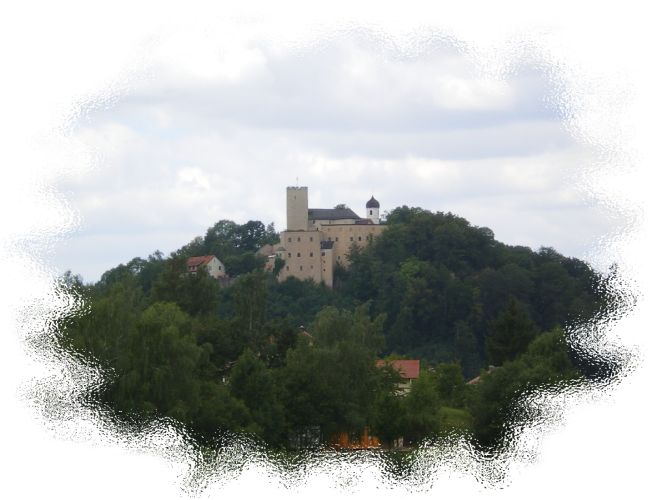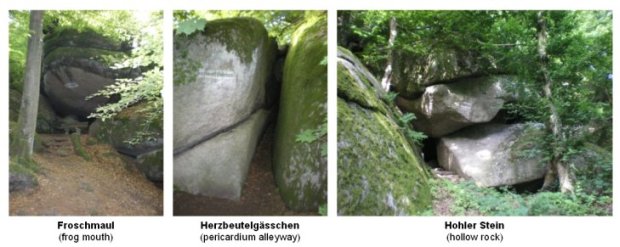ACHTUNG - Ihr befindet Euch
in einem Naturschutzgebiet!
Haltet Euch an die Regeln:
CAUTION! - You find yourselves in a
nature reserve!
Keep to the rules:

Burgberg
Falkenstein

 Deutsch:
Deutsch:
Rund um den Burgberg Falkenstein gibt es
zahlreiche Felsfreistellungen. Diverse markante Felsgebilde mit
Wollsackverwitterung und Felsengassen auf der Nordseite
(Felsengarten - NSG) haben eigene Namen erhalten. In den
Aufschlüssen bei Falkenstein sind Körnelgneise (weitgehend
homogenisierte Gneise (Diatexite), in der Grenzzone zwischen
nebulitischen Gneisen und Granit) im Übergang zu Kristallgranit 1
erschlossen.
Die Wollsackverwitterung (selten "Matratzenverwitterung") ist eine
Form der Verwitterung von Gesteinen. Dieser Verwitterungsvorgang
erfolgt immer unterirdisch und bringt abgerundete Formen hervor.
Von diesen runden Formen leitet sich auch der Name ab, da das
Gestein vom Aussehen her, mit Wolle gefüllten, groben Säcken
ähnlich sieht.
Aufschlüsse sind in der Geologie Stellen an denen das Gestein
unverhüllt an die Erdoberfläche tritt. Dies ist vor allem in
Abbaugebieten, Steinbrüchen, Baugruben, Felsfreistellungen der
Fall. Ein Aufschluss erfasst einen unterschiedlich ausgedehnten
räumlichen Abschnitt der Erdkruste.
Im Schlosspark findet ihr auch Informationstafeln, schaut euch
diese etwas genauer an, damit ihr die Fragen beantworten könnt.

Die "Klause":
Das Ensemble "Klause" besteht auf einem Felssporn mit typischer
Wollsackverwitterung, auf dem eine kapellenähnliche Hütte
steht.
Das "Froschmaul":
Das "Froschmaul" ist ein großer Felsblock mit einem Überhang im
Bereich des Felsengartens. Als Folge der Wollsackverwitterung sind
die markant gerundeten Felsformen entstanden. Durch tief
zurückgewitterte horizontale Trennflächen und dem Überhang entsteht
die Ähnlichkeit mit einem Froschmaul.
Der "hohle Stein":
Beim "hohlen Stein", auch "Herminensgrotte" genannt, handelt es
sich um eine aus wollsackartigen Granitblöcken bestehende
Überdeckungshöhle, die durch Herausgleiten eines Gesteinssegmentes
entstand.
Das "Herzbeutelgässchen":
Das "Herzbeutelgässchen" liegt etwas oberhalb vom "hohlen Stein".
Es erhielt seinen Namen von dem eingeklemmten, freihängenden Stein,
der die Form eines Herzbeutels hat und unter dem eine schmale Gasse
zwischen großen wollsackverwitterten Granitblöcken
durchführt.
Die "große Schanze":
Bei der "große Schanze", auch "Schanzl" genannt, handelt es sich um
einen großen wollsackverwitterten Felsenturm, der über eine
Holzbrücke erreichbar ist. Er diente vormals als vorgelagerte
Verteidigungswehr und war mit Kanonen bestückt, die allerdings im
Jahre 1809 von den Österreichern im Österreichischen Erbfolgekrieg
mitgenommen wurden.
Leuchtmoos:
In der mit einem Eisengitter verschlossenen Höhle findet sich das
in Deutschland sehr seltene Leuchtmoos. Hierbei handelt es sich um
Laubmoos, die das einfallende Licht in smaragdgrünem Glanz
reflektiert.
Logaufgaben:
- Aufgabe 1: Messe im „hohlen Stein“ den Abstand
zwischen den Felsen, wie im Bild dargestellt.
- Frage 1: Wie heißt die mittlere Schicht der Bäumstämme?
- Frage 2: Wie wird das Leuchtmoos noch genannt?
(Bei den Massangaben auf volle 10cm auf- oder abrunden.)
Schicke eine Email, mit deinem Nicknamen als Betreff, an die
folgende Adresse:
Falkenstein.Aufgabe 1.Frage 1.Frage 2@geocaching-cham.de
(Beispiel: Falkenstein.98cm.Baum.Moos@geocaching-cham.de)
Ist deine Antwort richtig, bekommst du automatisch deine
Logfreigabe.
Füge deinem Log bitte noch ein Foto von dem Platz bei, der dir hier
am besten gefallen hat.
 English:
English:
Around the Falkenstein Castle Hill there are
numerous areas with exposed rocks. Several striking rock formations
showing a special form of alteration called "bag of wool" and
alleys of rock at the north side were given their own names. In the
outcrops near Falkenstein grained gneisses (mostly homogenised
gneisses (Diatexits), in the border zone between nebulised gneisses
and granites in change-over to crystal granite 1 are maid
accessible.
The wool-bag alteration (or unusual "mattress alteration") is a
form of alteration of the rocks. This alteration process is always
happening subterraneous and creates rounded shapes. The name
results from this rounded shapes because they are likely to rough
sacks filled with wool.
Outcrops in the meaning of geology are places where the stone
appears bare to earth's surface. This is first of all the case in
mining sites, stone pits, building pits and areas of exposed rocks.
Each outcrop consists of a variable larged territorial segment of
earth crust.
In the palace garden you will also find several information panels.
Take a closer look at them in order to be able to answer the
questions.

The "Klause" (chasm):
The ensemble "Klause" consists of a spur of rocks with typical
above mentioned alteration called "bag of wool" with a cottage
similar to a chapel standing on it.
The "Froschmaul" (frog mouth):
The "Froschmaul" is a huge block of rocks with a bearing-out in the
area of the stone garden. As a consequence of the
"wool-bag-alteration" the striking rounded rock forms occured. With
the deeply weathered horizontal joint faces and with the
bearing-out the affinity with a frog mouth arises.
The "hohle Stein" (hollow rock):
By the "hohle Stein", also called "Herminensgrotte" it is the
matter of a overlap hole consisting of wool-bag like granit blocks
which was built by the slipping out of a stone segment.
The "Herzbeutelgässchen" (pericardium alleyway):
The "Herzbeutelgässchen" is situated just obove the "hohlen Stein".
It has got its name from the jammed, freely hanging rock which has
the form of a pericardium and below the rock there is a narrow
alleyway with big wool-bag altered granite blocks.
The "große Schanze" (big entrenchment):
By the "große Schanze", also called "Schanzl" it is the matter of a
huge, wool-bag-altered rock tower, which can be reached via a
timber bridge. In former times it worked as a upstream defence
embankment and was equipped with guns; but those were taken away by
the Austrians in the year 1809 during the austrian war of
succession.
The "Leuchtmoss" (shining moss):
Inside the hole locked with an iron grating you can find the
shining moss which is very rare in Germany. It is about a leaves
moss which is rejecting the incident light in its emerald green
gloss.
Log tasks:
- Task 1: In the "hollow rock" measure the distance between the
rocks as shown in the picture.
- Question 1: How is the middle layer of the boles called?
- Question 2: What is an alternative name for the shining
moss?
(At the measurements round up or down to full 10 cm.)
Send an email with your nickname in the subject line to:
Falkenstein.Task1.Question 1.Question 2@geocaching-cham.de
(Example: Falkenstein.98cm.tree.moss@geocaching-cham.de)
If your answer is correct you will automatically receive the log
release.
Please add also a photo to your log with your favour place
here.